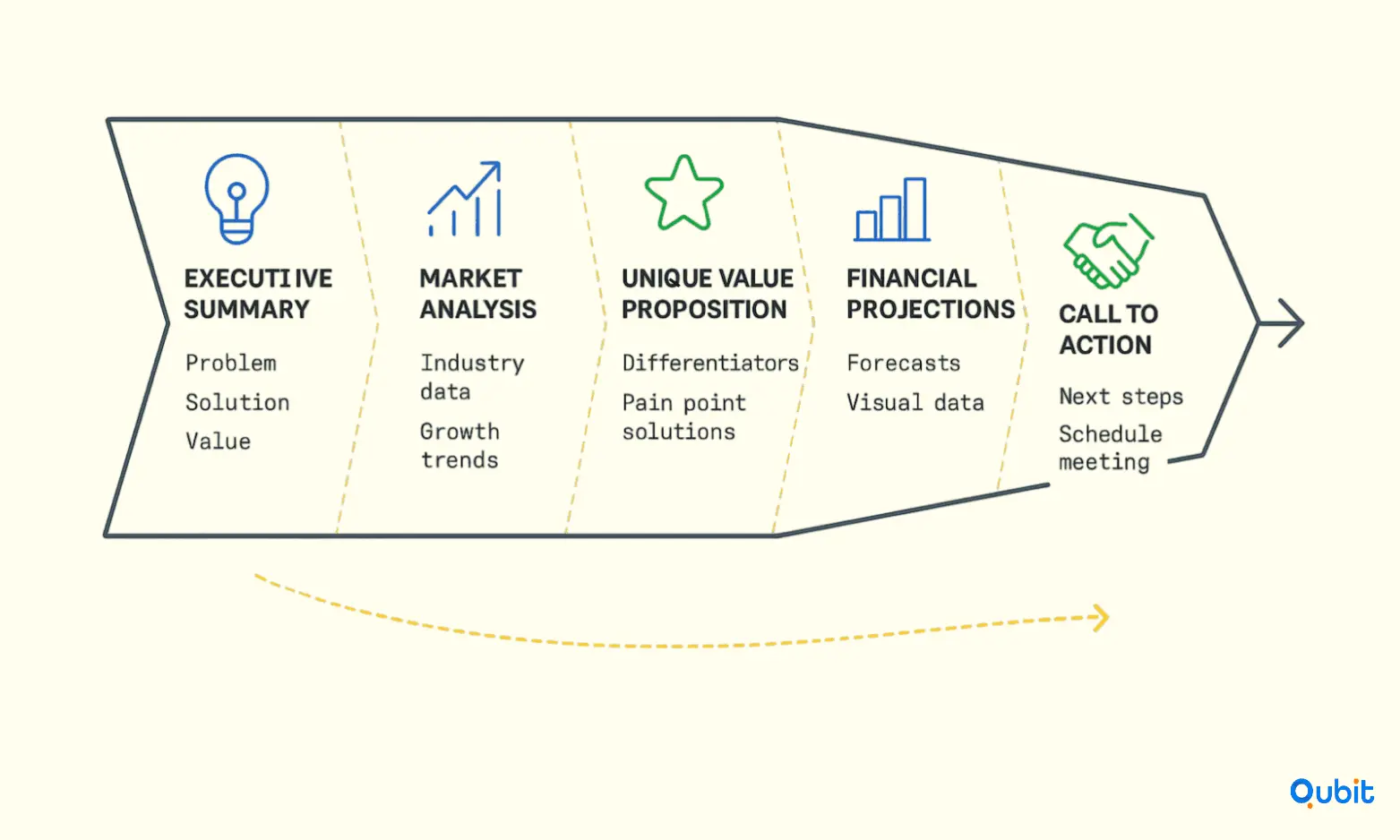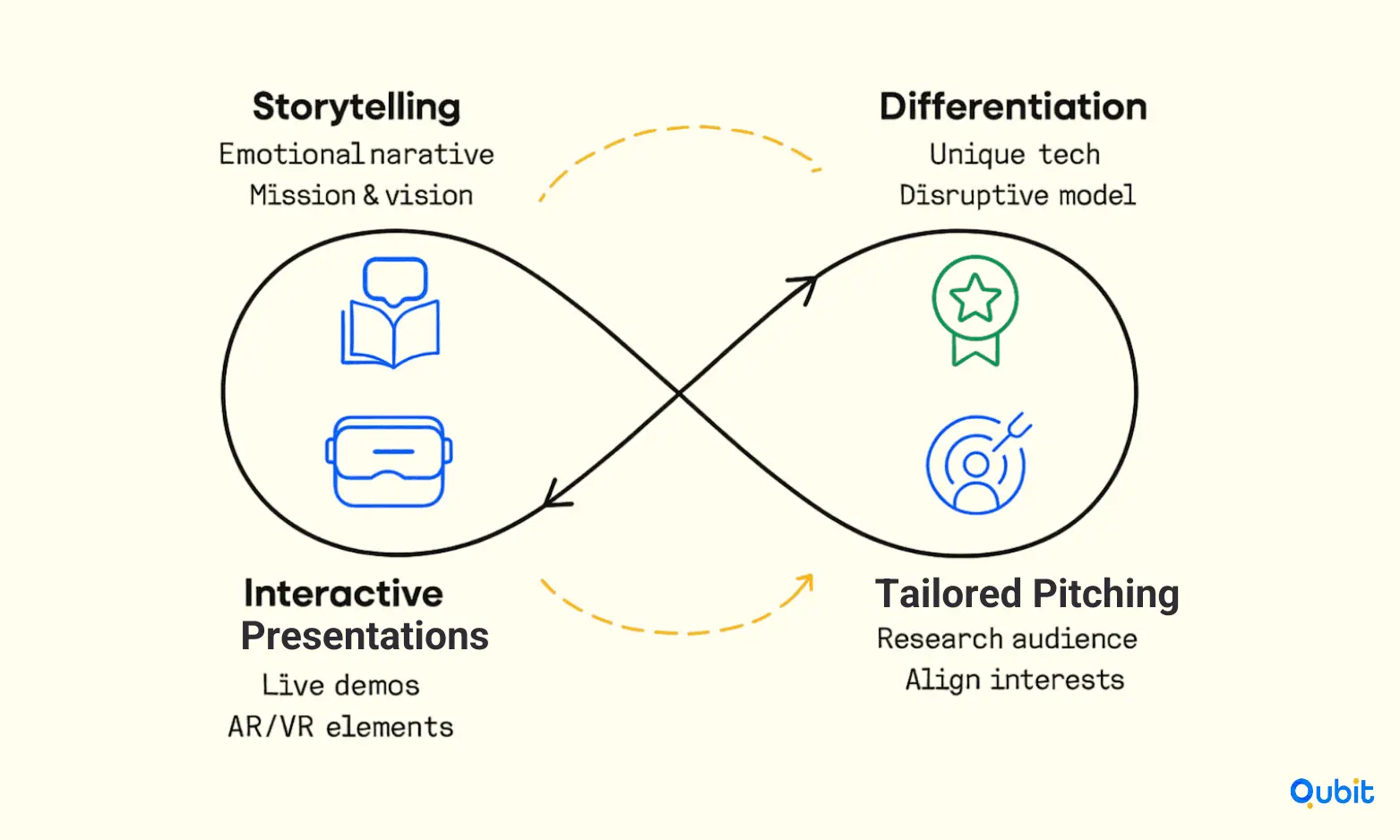A compelling pitch deck is the cornerstone of securing investment in the telecom industry. Whether you're aiming to attract venture capital or strategic partners, the right pitch deck combines technical precision, storytelling, and visual impact. With a proven track record of helping startups secure $100mill in funding, we understand the nuances of creating presentations that resonate with investors.
As your pitch deck expert, we’ll guide you through the essentials of crafting a telecom pitch deck that stands out. From highlighting market opportunities to showcasing innovative solutions, this guide will cover everything you need to know. For broader funding strategies, explore insights in how to secure funding for telecom startups.
Let’s dive in and transform your ideas into a winning pitch!
Overview of Telecom Pitch Decks
A telecom pitch deck serves as a concise yet impactful presentation designed to communicate the value proposition of a telecommunications business to potential investors or stakeholders. Its primary purpose is to distill complex information into a compelling narrative that highlights the company’s strengths, market opportunities, and growth potential.
To make a lasting impression, a telecom pitch deck must balance visual appeal with a clear, logical structure. Eye-catching design elements, such as infographics and charts, can simplify technical data, while a well-organized flow ensures the audience stays engaged. Each slide should build on the previous one, creating a cohesive story that resonates with the target audience.
What sets telecom pitch decks apart is their focus on industry-specific elements, such as network infrastructure, scalability, and technological innovation. These presentations must address the unique challenges and opportunities within the telecom sector, ensuring that investors understand the competitive edge and long-term vision of the business.
Core Components of a Telecom Pitch Deck
Crafting a compelling telecom pitch deck requires a blend of precision, relevance, and audience-centric customization. Each component must work cohesively to deliver a clear and persuasive narrative.

1. Executive Summary
Begin with a concise overview that highlights the problem, your solution, and the value proposition. This section sets the tone and should immediately capture the audience's interest.
2. Market Analysis
Provide data-driven insights into the telecom industry, including market size, growth trends, and key opportunities. Tailor this section to reflect the specific interests of your target audience, whether they are investors, partners, or clients.
3. Unique Value Proposition
Clearly articulate what sets your telecom solution apart. Focus on the unique benefits and innovations that address the audience’s pain points.
4. Business Model
Outline how your telecom solution generates revenue. Include details on pricing strategies, customer acquisition plans, and scalability potential.
5. Financial Projections
Present realistic and transparent financial forecasts. Use charts and graphs to make this data easy to digest.
6. Call to Action
End with a strong, actionable closing that specifies the next steps, such as scheduling a meeting or exploring partnership opportunities.
By ensuring clarity and tailoring each section to your audience, your pitch deck becomes a powerful tool for engagement and persuasion.
Step-by-Step Telecom Pitch Deck Creation Process
Crafting a telecom pitch deck that grabs investor attention requires a structured approach and clear messaging. This guide breaks down the process into actionable steps, ensuring your presentation flows logically and maximizes impact.
1. Define Your Core Message
Start by identifying the central theme of your pitch. What problem does your telecom solution solve? Investors need to understand your value proposition within the first few slides. Keep your messaging concise and focused, avoiding technical jargon unless necessary.
2. Structure the Deck for Logical Flow
Organize your pitch deck into distinct sections:
- Introduction: Present your company and its mission.
- Problem Statement: Highlight the telecom industry challenge you aim to address.
- Solution: Explain your product or service and how it resolves the problem.
- Market Opportunity: Provide data-driven insights into the market size and growth potential.
- Business Model: Outline how your solution generates revenue.
- Financials: Share projections and key metrics that demonstrate profitability.
- Team: Showcase the expertise of your leadership team.
3. Enhance Visual Appeal
Visuals play a crucial role in maintaining investor engagement. Use charts, graphs, and infographics to present complex data in a digestible format. Stick to a clean design with consistent fonts and colors. Avoid cluttered slides—each should focus on one key idea.
4. Focus on Clarity and Simplicity
Every slide should communicate a single, clear message. Use bullet points and short sentences to keep text minimal. Ensure that your visuals complement the narrative rather than overwhelm it.
5. Tailor the Deck to Your Audience
Research your potential investors and customize the pitch deck to align with their interests. Highlight aspects of your telecom solution that resonate with their portfolio or investment goals.
6. End with a Strong Call-to-Action
Conclude your pitch with a compelling CTA that encourages investors to take the next step. Whether it’s scheduling a follow-up meeting or requesting additional information, make it easy for them to act.
Understanding Your Audience for a Strong Telecom Pitch Deck
Start by identifying the demographics of your target investors. Are they seasoned venture capitalists, corporate executives, or tech-savvy angel investors? Knowing their professional experience and industry focus helps you align your pitch with their interests. For instance, tech investors may prioritize innovation, while corporate stakeholders might focus on scalability and ROI.
Next, delve into their expectations. Research past investments or partnerships to uncover patterns in their decision-making. Highlighting how your telecom solution addresses their specific pain points, such as market competition or operational inefficiencies, can make your pitch more persuasive.
Finally, ensure your presentation resonates emotionally. Use relatable examples and data-driven insights to demonstrate how your solution solves real-world challenges. A pitch deck that speaks directly to the audience’s needs not only captures attention but also builds trust and credibility.
Harnessing Storytelling to Enhance Telecom Pitch Decks
A compelling story can transform a telecom pitch deck from a collection of data points into a narrative that resonates deeply with investors. By weaving storytelling into your presentation, you create an emotional connection that goes beyond numbers, fostering trust and engagement. Investors are more likely to remember and relate to a pitch that feels authentic and human, rather than one that simply lists technical achievements.
Crafting an emotionally engaging narrative requires focusing on authenticity. Share the journey of your telecom startup—its challenges, milestones, and vision for the future. This approach not only highlights your company’s unique identity but also differentiates your pitch deck from competitors who may rely solely on statistics.
A well-told story also provides context for your data, making it easier for investors to understand the significance of your metrics. The narrative techniques in storytelling for telecom pitch deck illustrate how a well-structured story can foster investor trust and enhance your pitch deck’s impact.
By integrating storytelling, you can elevate your pitch deck into a memorable experience that captures both the minds and hearts of your audience.
Design and Visual Strategy in Telecom Pitch Decks
First impressions matter, especially when presenting to investors. A well-designed telecom pitch deck can immediately capture attention and set the tone for a compelling presentation. Professional design elements, such as clean layouts, cohesive color schemes, and high-quality visuals, create an air of credibility that resonates with your audience.
Visuals also play a pivotal role in simplifying complex telecom concepts. By using infographics, charts, and diagrams, intricate data can be transformed into digestible insights. This not only makes the information more accessible but also keeps the audience engaged throughout the presentation. For instance, a graph illustrating market growth trends can convey more in seconds than a lengthy paragraph ever could.
Consistency in design further strengthens your message. A unified visual theme across slides ensures that your pitch feels polished and professional, which can significantly enhance your overall communication. From typography to iconography, every detail contributes to building trust and reinforcing your brand identity.
Ultimately, a strong visual strategy is not just about aesthetics—it’s about clarity and impact. By combining professional design with effective visuals, telecom pitch decks can leave a lasting impression on investors, paving the way for meaningful conversations and potential partnerships.
Preparing for Investor Questions in Telecom Pitch Decks
Anticipating investor questions is a critical step in refining your telecom pitch deck. Investors often probe deeply into financial projections, market opportunities, and competitive positioning, so being prepared with precise, data-driven answers is essential. Start by identifying potential objections or areas of concern that may arise during your presentation. This could include questions about scalability, customer acquisition costs, or regulatory challenges.
Confidence stems from preparation. Rehearse your responses to common queries, ensuring they are concise and backed by reliable data. For example, if asked about market share, present clear statistics and trends that validate your projections. Practicing with a mentor or team can also help you refine your delivery and address any gaps in your responses.
When faced with challenging questions, clarity is your strongest ally. Avoid overcomplicating your answers; instead, focus on delivering straightforward explanations that demonstrate your expertise and understanding of the telecom industry. Remember, a well-prepared response not only builds trust but also showcases your commitment to the venture.
Best Practices to Perfect Your Telecom Pitch Deck
Crafting a telecom pitch deck that resonates requires a blend of strategy and creativity. To stand out, focus on these actionable best practices:
Start with a compelling story: Begin your pitch deck with a narrative that highlights the problem your telecom solution addresses. A relatable story helps investors connect emotionally with your vision.
Use visuals to amplify your message: Incorporate charts, infographics, and diagrams to simplify complex telecom data. Visuals not only break up text-heavy slides but also make your key points more memorable.
Integrate data-driven insights: Showcase market trends, customer acquisition metrics, and financial projections to build credibility. Ensure your data is accurate and presented in a concise format to avoid overwhelming your audience.
Tailor content to investor expectations: Research your audience beforehand and align your pitch deck with their priorities. Highlight ROI potential, scalability, and competitive advantages to address their specific concerns.
Maintain a logical flow: Structure your deck to guide investors seamlessly from the problem to the solution, market opportunity, and financials. A clear progression keeps your audience engaged.
By combining storytelling, visuals, and data, your telecom pitch deck can effectively capture investor interest and drive results.
Advanced Strategies and Considerations for Telecom Pitch Decks
Crafting a telecom pitch deck that stands out requires a deep dive into advanced market insights, technological trends, and regulatory frameworks. A successful presentation integrates these elements to demonstrate not only market potential but also the foresight to address industry-specific challenges.
1. Comprehensive Market Analysis
Investors expect a pitch deck to reflect a thorough understanding of the telecom market. This includes identifying growth opportunities, analyzing competitor positioning, and highlighting untapped customer segments. Incorporating data-driven insights, such as market size projections and revenue forecasts, can substantiate your claims and build credibility.
2. Technology Innovation as a Differentiator
Highlighting cutting-edge technologies is essential in the telecom sector. Whether it’s advancements in 5G, IoT, or AI-driven network optimization, showcasing your company’s ability to innovate can set you apart. Be specific about how these technologies will enhance operational efficiency or create new revenue streams.
3. Addressing Regulatory Factors
Telecom is a heavily regulated industry, and demonstrating awareness of compliance requirements is critical. Outline how your business model aligns with current regulations and how you plan to adapt to future policy changes.
For more advanced, stage-specific considerations, explore the detailed breakdown in the telecom series a pitch deck. This resource provides insights into aligning your presentation with investor expectations.
Innovative Approaches to Telecom Startup Pitching

Standing out in the competitive telecom industry requires more than just a solid business plan. Creative pitching techniques can make all the difference in capturing investor interest. One effective strategy is to focus on storytelling. By weaving your startup’s mission, challenges, and vision into a compelling narrative, you can create an emotional connection that resonates with your audience.
Another innovative method involves interactive presentations. Instead of relying solely on slides, consider incorporating live demos, augmented reality (AR), or virtual reality (VR) elements to showcase your product’s potential. These tools not only engage your audience but also provide a tangible experience of your solution’s value.
Differentiation is key in a crowded market. Highlighting what sets your telecom startup apart—whether it’s a unique technology, a disruptive business model, or an untapped market—can make your pitch unforgettable. Additionally, using visually striking designs and concise messaging ensures your presentation is both memorable and impactful.
Finally, tailor your pitch to your audience. Researching investor preferences and aligning your presentation with their interests demonstrates preparation and professionalism. By combining creativity with strategic focus, telecom startups can deliver pitches that leave a lasting impression.
Real-World Examples of Telecom Pitch Decks
Successful telecom pitch decks often showcase tailored strategies that align with specific business models and market opportunities. For instance, A 5G Infrastructure Startup highlights cutting-edge solutions for scalable network deployment. This example emphasizes the investment potential of advanced 5G technologies, making it a compelling case for stakeholders interested in rapid 5G adoption.
Another standout example is an IoT Connectivity Platform, which focuses on integrating smart technology into connected devices. This pitch deck demonstrates innovative strategies for addressing the growing demand in the IoT market, showcasing scalable solutions that cater to expanding connectivity needs.
Both examples illustrate how telecom businesses can craft their presentations to resonate with investors and partners. Whether emphasizing high-speed connectivity or smart device integration, these pitch decks provide practical insights into aligning business goals with market trends.
These case studies serve as a reference point for telecom companies aiming to refine their strategies. By studying these real-world examples, businesses can better understand how to position their offerings effectively and capitalize on emerging opportunities in the telecom sector.
Reach out to us at Qubit Capital for expert pitch deck creation services to take your pitch deck to the next level. Let’s turn your vision into a compelling story that drives results.
Common Investor Questions for Telecom Pitch Decks
Investor meetings often revolve around critical questions that test a startup's preparedness and vision. Telecom entrepreneurs can expect inquiries that delve into market positioning, scalability, and financial projections.
Typical Investor Questions
What is your unique value proposition in the telecom sector?
Investors want clarity on how your offering stands out in a competitive market. Highlight specific innovations, cost advantages, or customer benefits that differentiate your business.How scalable is your business model?
Demonstrating scalability is crucial. Be prepared to explain how your infrastructure, technology, or partnerships can support growth without proportionally increasing costs.What are your revenue streams and financial projections?
Investors often scrutinize financial details. Provide clear, data-backed projections and outline diverse revenue streams to showcase stability and growth potential.What challenges do you foresee, and how will you address them?
Transparency about potential hurdles builds trust. Share your risk mitigation strategies, whether they involve regulatory compliance, technology upgrades, or market competition.
Preparation Tips
Anticipating these questions and crafting concise, confident responses can significantly enhance your pitch. A well-prepared deck not only answers these queries but also demonstrates your strategic foresight.
Promoting Your Telecom Pitch Deck Template
Crafting a compelling pitch deck can be a daunting task, but the right tools can make all the difference. Our specialized Pitch Deck Template is designed to simplify the process, enabling telecom professionals to create investor-ready presentations with ease. This template has already proven its value, helping clients secure over $4 million in funding, a testament to its effectiveness.
Whether you're seeking funding for a startup or scaling an established business, this template provides a streamlined framework that ensures your message resonates with investors. Its structured design focuses on clarity and impact, allowing you to highlight your unique value proposition and financial potential.
Visualizing Financial Data with Powerful Templates
Transforming complex financial data into clear, visually engaging formats can make all the difference in decision-making. Financial professionals often rely on diverse chart options, such as bar, line, pie, and area charts, to distill intricate datasets into digestible insights. These tools not only simplify the presentation of numbers but also help highlight key financial trends and comparisons effectively.
For instance, bar charts are ideal for comparing revenue streams across different time periods, while line charts excel at showcasing trends like stock performance or expense growth over time. Pie charts, on the other hand, are perfect for illustrating proportions, such as the allocation of a budget or market share distribution. Area charts combine the benefits of line and bar charts, offering a dynamic way to visualize cumulative data like total assets or liabilities.
By selecting the right visualization technique, businesses can ensure their financial reports are not just informative but also compelling. This approach fosters better understanding among stakeholders, enabling quicker and more informed decisions. Whether you're presenting to investors or internal teams, the right visual template can turn raw data into actionable insights.
Tailored Investor Pitch Deck Templates
Crafting a compelling pitch deck for investors requires precision and clarity. These tailored templates are specifically designed to showcase a startup’s financial health and future potential. By focusing on transparency, they help businesses present their financial performance in a way that builds trust and confidence.
Each template includes dedicated sections for financial projections, profit and loss (P&L) statements, cash flow analysis, and balance sheets. This structured approach ensures that all critical metrics are covered, leaving no room for ambiguity. Startups can effectively communicate their growth trajectory and demonstrate their financial stability, making it easier for investors to assess the opportunity.
Moreover, these templates simplify complex financial data, turning it into digestible insights. Whether it’s highlighting revenue streams or forecasting future growth, the emphasis remains on clarity and accuracy. This not only strengthens the narrative but also aligns with the expectations of discerning investors.
Concise Executive Summary Templates for Telecom Startups
Crafting an executive summary that resonates with decision-makers is essential for telecom startups aiming to stand out. These templates are designed to provide a high-level overview of your company’s financial health, growth metrics, and strategic goals, ensuring clarity and brevity.
Each template focuses on presenting a snapshot of your startup’s financial performance, including revenue trends, profit margins, and cash flow. Key growth indicators, such as customer acquisition rates and market expansion efforts, are summarized to highlight progress. Additionally, strategic objectives are outlined succinctly, offering a clear roadmap for future initiatives.
Busy executives often lack the time for lengthy reports. These templates are tailored to facilitate quick yet comprehensive reviews, enabling stakeholders to grasp critical insights without sifting through excessive details.
Conclusion
Crafting a compelling telecom pitch deck requires a blend of strategic storytelling and robust data presentation. Throughout this guide, we’ve explored actionable strategies to ensure your pitch deck stands out—from structuring a clear narrative to integrating data that resonates with investors. By focusing on clarity and relevance, you can effectively communicate your vision and value proposition.
A well-designed pitch deck is not just a presentation; it’s a tool to build trust and spark interest. Prioritizing a narrative-driven approach supported by data ensures your message is both engaging and credible. If you’re ready to elevate your telecom pitch deck and connect with the right investors, we’re here to help.
If you’re looking to align your deck with what VCs actually screen for, at Qubit we understand market sizing, 5G/AI roadmaps, and traction that passes the sniff test. Level up with our fundraising assistance for telecom startups and schedule a discovery session.
Key Takeaways
- Understand the unique components required for a successful telecom pitch deck.
- Follow a structured, step-by-step creation process that emphasizes clarity and data-driven design.
- Leverage storytelling techniques to emotionally engage investors.
- Prepare thoroughly for investor questions with tailored strategies.
- Utilize proven templates and case studies to secure significant funding.
Frequently asked Questions
What should be included in a telecom pitch deck?
A well-crafted telecom pitch deck should encompass essential elements such as market analysis, technical infrastructure, financial projections, and a compelling narrative. These components should address telecom-specific challenges and opportunities, ensuring the deck resonates with potential investors.






